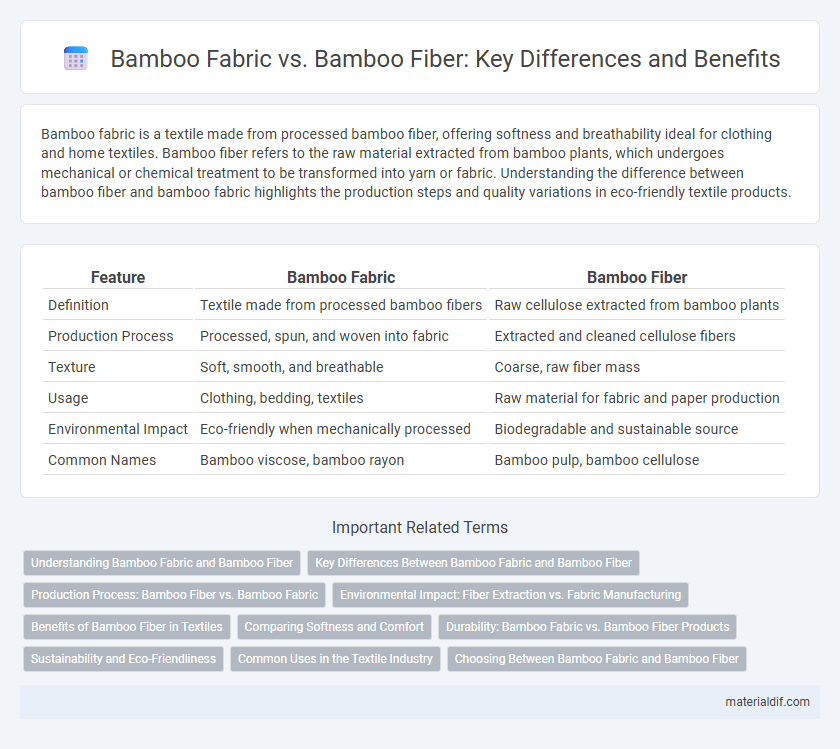Bamboo fabric is a textile made from processed bamboo fiber, offering softness and breathability ideal for clothing and home textiles. Bamboo fiber refers to the raw material extracted from bamboo plants, which undergoes mechanical or chemical treatment to be transformed into yarn or fabric. Understanding the difference between bamboo fiber and bamboo fabric highlights the production steps and quality variations in eco-friendly textile products.
Table of Comparison
| Feature | Bamboo Fabric | Bamboo Fiber |
|---|---|---|
| Definition | Textile made from processed bamboo fibers | Raw cellulose extracted from bamboo plants |
| Production Process | Processed, spun, and woven into fabric | Extracted and cleaned cellulose fibers |
| Texture | Soft, smooth, and breathable | Coarse, raw fiber mass |
| Usage | Clothing, bedding, textiles | Raw material for fabric and paper production |
| Environmental Impact | Eco-friendly when mechanically processed | Biodegradable and sustainable source |
| Common Names | Bamboo viscose, bamboo rayon | Bamboo pulp, bamboo cellulose |
Understanding Bamboo Fabric and Bamboo Fiber
Bamboo fabric is a textile material made by processing bamboo fiber into yarn and then weaving or knitting it into fabric, offering softness, breathability, and eco-friendly qualities. Bamboo fiber refers to the raw natural cellulose extracted from bamboo plants, which can be mechanically or chemically processed before becoming fabric. Understanding the distinction between bamboo fabric and bamboo fiber is crucial for recognizing their respective environmental impacts and textile properties.
Key Differences Between Bamboo Fabric and Bamboo Fiber
Bamboo fabric is a textile produced by processing bamboo fiber through mechanical or chemical methods, resulting in a soft, breathable material used in clothing and home textiles. Bamboo fiber refers specifically to the raw natural fibers extracted directly from the bamboo plant, which can be spun into yarn before fabric production. Key differences include bamboo fabric being a finished product ready for use, while bamboo fiber is the unprocessed material serving as the primary input in fabric manufacturing.
Production Process: Bamboo Fiber vs. Bamboo Fabric
Bamboo fiber is derived from raw bamboo stalks through chemical or mechanical processes that break down the plant into cellulose fibers, whereas bamboo fabric is the end product made by spinning these fibers into yarn and weaving or knitting them into textiles. The production of bamboo fiber often involves environmentally intensive methods such as chemical pulping, while bamboo fabric manufacturing emphasizes softness and durability through additional treatments like bleaching or dyeing. Understanding the distinct stages from fiber extraction to fabric finishing highlights the complexity and sustainability challenges in creating bamboo-based textiles.
Environmental Impact: Fiber Extraction vs. Fabric Manufacturing
Bamboo fiber extraction involves chemically intensive processes that can generate toxic waste, significantly affecting water quality and ecosystems. Conversely, bamboo fabric manufacturing, especially mechanical methods, reduces environmental harm by utilizing sustainable harvesting and minimal chemical use. Evaluating the environmental impact requires considering both fiber extraction methods and fabric production techniques to ensure eco-friendly bamboo textile solutions.
Benefits of Bamboo Fiber in Textiles
Bamboo fiber, derived from the pulp of bamboo plants, offers significant benefits in textiles including natural antibacterial properties, moisture-wicking capabilities, and exceptional breathability, making it ideal for activewear and sensitive skin. Its sustainable cultivation and biodegradability contribute to environmentally friendly fashion, reducing reliance on synthetic fibers and minimizing ecological impact. Furthermore, bamboo fiber's softness and durability enhance comfort and longevity in garments, supporting both consumer satisfaction and sustainable production.
Comparing Softness and Comfort
Bamboo fabric offers superior softness and breathability compared to bamboo fiber, as it is processed into a finer, smoother textile ideal for sensitive skin. Bamboo fiber, being raw and less refined, tends to be coarser and less comfortable for direct contact. The natural moisture-wicking and hypoallergenic properties of bamboo fabric enhance comfort significantly over untreated bamboo fiber.
Durability: Bamboo Fabric vs. Bamboo Fiber Products
Bamboo fabric, derived from bamboo fiber, undergoes processing that impacts its durability, often making it less resilient than raw bamboo fiber products. Bamboo fiber, in its natural state, retains greater strength and resistance to wear, ideal for heavy-use applications. However, bamboo fabric offers a softer texture and breathability, balancing comfort with moderate durability for apparel and home textiles.
Sustainability and Eco-Friendliness
Bamboo fiber, derived directly from bamboo plants, is a natural, biodegradable material known for its minimal environmental impact during cultivation, requiring no pesticides or fertilizers. Bamboo fabric, often produced by chemically processing bamboo fiber into rayon or viscose, has a higher ecological footprint due to the use of toxic chemicals and energy-intensive manufacturing. Choosing bamboo fiber over chemically processed bamboo fabric significantly enhances sustainability by reducing pollution and promoting eco-friendly textile options.
Common Uses in the Textile Industry
Bamboo fabric, derived from processed bamboo fibers, is widely used in the textile industry for making soft, breathable clothing such as T-shirts, underwear, and activewear due to its moisture-wicking and antibacterial properties. Bamboo fiber itself, often in the form of viscose or rayon, serves as a key raw material in producing sustainable textiles including bed linens, towels, and upholstery. Both bamboo fabric and bamboo fiber play significant roles in eco-friendly fashion and home textile markets, valued for their biodegradability and renewable sourcing.
Choosing Between Bamboo Fabric and Bamboo Fiber
Bamboo fabric refers to the material made from processed bamboo fibers, often chemically transformed into viscose or rayon for softness and durability, while bamboo fiber denotes the raw, natural fibers extracted from the bamboo plant before processing. Choosing between bamboo fabric and bamboo fiber depends on the intended use: bamboo fabric offers a smoother texture ideal for clothing and textiles, whereas bamboo fiber retains more natural antimicrobial properties beneficial for eco-friendly applications. Understanding these differences helps consumers prioritize comfort, sustainability, and performance in bamboo-based products.
Bamboo fabric vs bamboo fiber Infographic

 materialdif.com
materialdif.com